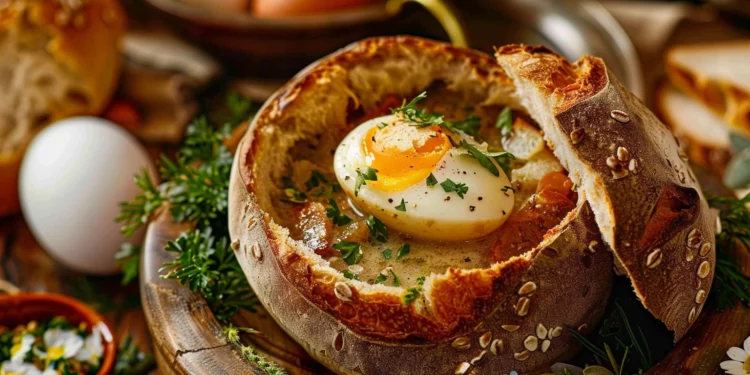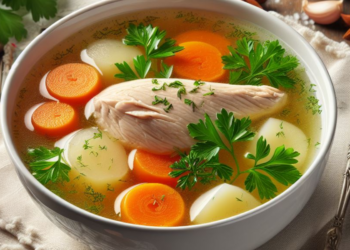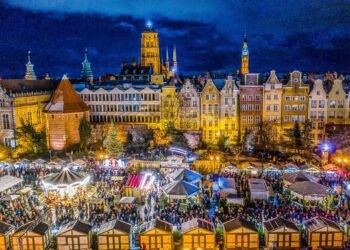Easter in Poland is a time of rich traditions, vibrant celebrations, and, most importantly, delicious food that has been passed down through generations. Among these culinary delights, Żurek stands out—a hearty, soul-warming soup that embodies the essence of Polish hospitality and the rejuvenating spirit of spring. This post will take you on a journey through the history of Żurek, guide you through the process of making it from scratch, and share tips to ensure your soup boasts that sought-after homemade taste. Whether you’re of Polish heritage or simply a culinary explorer, this traditional Żurek recipe will add a touch of authenticity to your Easter feast.
Żurek’s roots weave through the fabric of Polish culture, tracing back to the Middle Ages. Originally a peasant dish, it has graced tables across the country, evolving into a beloved Easter classic. Central to Żurek is its unique sour rye base, or “żur,” a fermented mixture that imparts a distinctive tangy flavor, reflecting the Polish penchant for sour soups that predate the nation’s love affair with cream and tomato-based broths.
The soup is traditionally served during Easter, marking the end of Lent’s fasting period with its rich, meaty ingredients—a celebration of renewal and abundance. However, its simplicity, deep flavors, and comforting qualities have made Żurek a year-round favorite in Polish homes.
Using store-bought zakwas simplifies the process, making it accessible for beginners while still delivering that homemade taste. Here’s how to make traditional Polish Easter Żurek from the comfort of your kitchen.
Ingredients:
- 1 liter of store-bought zakwas (sour rye soup base): The foundation of żurek, providing its characteristic sour flavor.
- 500g (about 1 pound) of Polish white sausage: Use raw sausage for boiling or pre-cooked sausage for frying.
- 200g (about 7 ounces) of boczek (smoked bacon), diced: Adds a smoky depth to the soup.
- 2-3 medium potatoes, peeled and cubed: They thicken the soup and add texture.
- 1 large onion, diced: A base flavor for many soups.
- 2-3 cloves of garlic, minced: Adds a rich depth of flavor.
- 2 tablespoons of oil (if frying sausage and boczek): For sautéing.
- 1 bay leaf: Adds aromatic depth.
- 4-5 allspice berries: Introduce a subtle complexity.
- Salt and pepper to taste
- Hard-boiled eggs, quartered, for serving: A traditional garnish.
- Fresh marjoram for garnish (optional): Adds freshness and color.
Instructions:
Prepare the Ingredients:
- Prep the Vegetables: Cube the potatoes, dice the onion, and mince the garlic. Set aside.
Cook the Sausage:
- For Raw Sausage: If your sausage is raw, place it in a pot, cover with water, and bring to a boil. Simmer for about 20 minutes until cooked through. Remove the sausage, let it cool, and slice. Reserve the cooking water as part of your broth.
- For Pre-Cooked Sausage: If using pre-cooked or smoked sausage, slice it, and you’ll fry it with boczek in the following steps.
Fry Boczek (and Pre-Cooked Sausage if Applicable):
- Sauté Boczek (and Sausage): Heat oil in a large pot over medium heat. Add diced boczek (and sliced pre-cooked sausage if using) to the pot. Fry until the boczek is crispy and golden. For pre-cooked sausage, you’re aiming to brown it slightly and render out some fat.
Combine the Soup Base:
- Sauté Onion and Garlic: Add the diced onion to the pot with boczek (and sausage if you’re frying it together), cooking until the onion is translucent and soft. Add the minced garlic and cook for another minute until fragrant.
- Add Potatoes and Spices: Add the cubed potatoes to the pot, along with the bay leaf, allspice berries, salt, and pepper. Pour in the reserved water from boiling the sausage (if you boiled your sausage) or use 2 liters of water (if your sausage was pre-cooked).
- Cook the Soup: Bring the mixture to a boil, then reduce the heat and simmer until the potatoes are tender, about 15-20 minutes.
Add Zakwas and Sausage:
- Incorporate Zakwas: Once the potatoes are tender, reduce the heat to low and slowly stir in the zakwas. It’s important to ensure the soup is not boiling when adding zakwas to prevent curdling.
- Add Sausage: If you boiled your sausage earlier, add the sliced sausage to the soup now.
- Heat Through: Warm the soup gently, just until heated through. Do not boil after adding the zakwas. Taste and adjust seasoning with salt and pepper.
Season the Soup:
- Taste the soup and adjust the seasoning as needed with salt and pepper. The flavor should be a balance of savory and sour, characteristic of a traditional Żurek.
Serve:
- Prepare Eggs: While the soup is finishing, quarter your hard-boiled eggs.
- Serve: Ladle the hot soup into bowls, making sure to include sausage and potatoes in each serving. Add a quartered egg to each bowl and garnish with fresh marjoram if using. You can serve it in a crusty loaf of bread for an authentic, rustic Polish experience. Simply find a round loaf of crusty sour dough bread, cut off the top, scoop out the inside, and pour in your soup.
Tips for a Homemade Taste:
- Quality Zakwas: Choose a high-quality, store-bought zakwas for the best flavor foundation.
- Simmer Gently: After adding the zakwas, gently warm the soup without bringing it to a boil to preserve the delicate flavors.
- Balance the Sourness: Adjust the sourness by adding more or less zakwas according to your taste.
- Freshness Matters: Use fresh potatoes and high-quality, fresh or properly stored smoked sausage and boczek for the best flavor.
- Let It Sit: Żurek develops more flavor after sitting for a few hours. If you can, make it a day ahead and reheat gently before serving.
Embracing the tradition of Polish Żurek not only enriches your Easter table but connects you with centuries of culinary heritage. This soup, with its deep flavors and heartwarming qualities, is a celebration of spring, renewal, and the joy of shared meals. By following this guide, you’ll not only craft a dish that’s steeped in tradition but also discover the pleasure of creating something truly authentic and homemade. So this Easter, or whenever you crave a touch of Polish comfort, let Żurek be a testament to your culinary adventure and a bridge to the rich tapestry of Polish culture. Smacznego!

















